OUTCOME 2: STRATEGIES
Environment Management and Sustainable Water Resources Development Optimized for Basin-Wide Benefits by National Sector
INDICATORS:
• Number of transboundary national and provincial policies and plans integrating MRC basin-wide analysis and strategies • Evidence that national plans benefit from basin-wide strategies and action plans
HIGHLIGHTS A sustainable Mekong River Basin is predicated on national development plans that are optimized to increase basin-wide benefits and include measures for the avoidance, minimization, and mitigation of negative transboundary impacts. To achieve this outcome, the MRC completed the development of basin-wide sector strategies and action plans that would be integrated by MCs into their national frameworks to yield these regional benefits. These strategies and action plans include the MASAP, the BFMS, the SBEM, the DMS, and the Master Plan for Waterborne Transportation (Navigation Master Plan). After presenting the SHDS to the MRC Council and Joint Committee in 2020, the MRC continued to work on finalizing it in preparation for its scheduled endorsement by the MRC Joint Committee and approval by the MRC Council in 2021. Four NIPs, one for each country, for 2016–2020, and the GAP 2017–2020 were also prepared and approved. Five transboundary projects under the M-IWRM project were also implemented successfully.
Together, these strategies and plans provided critical input in producing the BDS 2021–2030 and MRC SP 2021–2025, which took into account the basin-wide, sector-specific strategic directions as well as activities, and redefined them into integrated basin-wide common directions and action points. At the national level, notable early adoptions of these strategies include the use of: MASAP by some MCs to bolster their technical and financial capacity for climate change adaptation, and help with their nationally determined contributions (NDCs); the Navigation Master Plan to implement selected priority navigation projects related to improving inland waterway navigation rules and policies; and the National Indicative Plans for the Cambodian-Thai joint project in the 9C-9T sub-basin to tackle common transboundary challenges related to flood and drought management, and the Cambodian–Lao joint project on water resources management and monitoring in the Khone Falls area.
Sustainable Hydropower Development Strategy Informed by MRC studies as well as a specific SHDS, the strategy presents the strategic priorities and actions at the basin level by the LMB countries to address hydropower opportunities and risks, and strengthen basin-wide cooperation for the sustainable development of the Mekong River Basin, in line with the 1995 Mekong Agreement (see Figure 14).
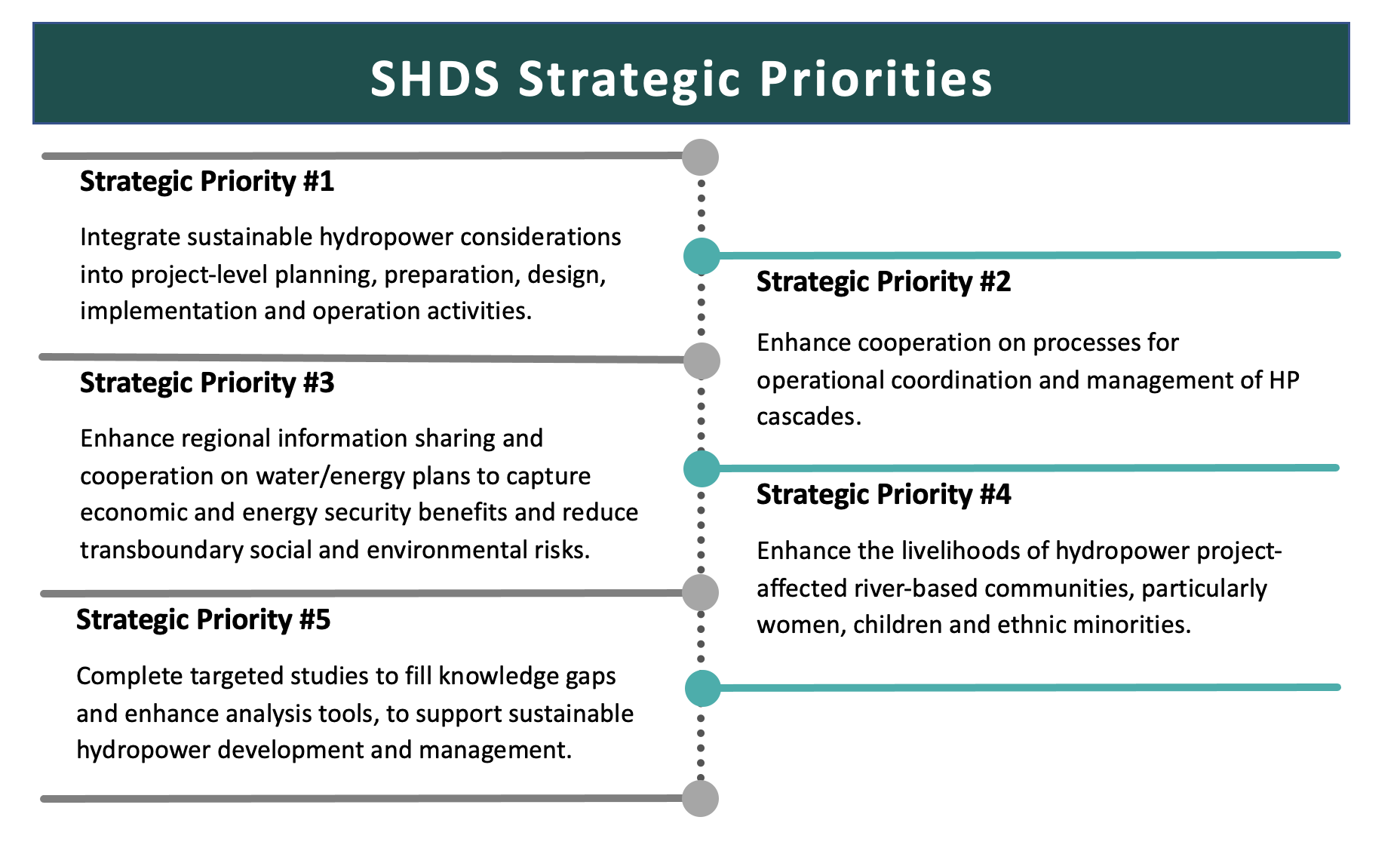
Figure 14. Strategic priorities of the Sustainable Hydropower Development Strategy
The Fisheries Management and Development Strategy The BFMS is a regional strategy for the responsible and sustainable use of living aquatic resources with a focus on inland capture fisheries. Its Project -based Action Plan is designed to facilitate and synergize projects of regional pertinence for the management and development of inland capture fisheries in the LMB. It prioritizes sustainable use and conservation of fish resources as first and utmost priority, focusing on stakeholder participation, gender equity, and property rights in fisheries management and development (see Figure 15).
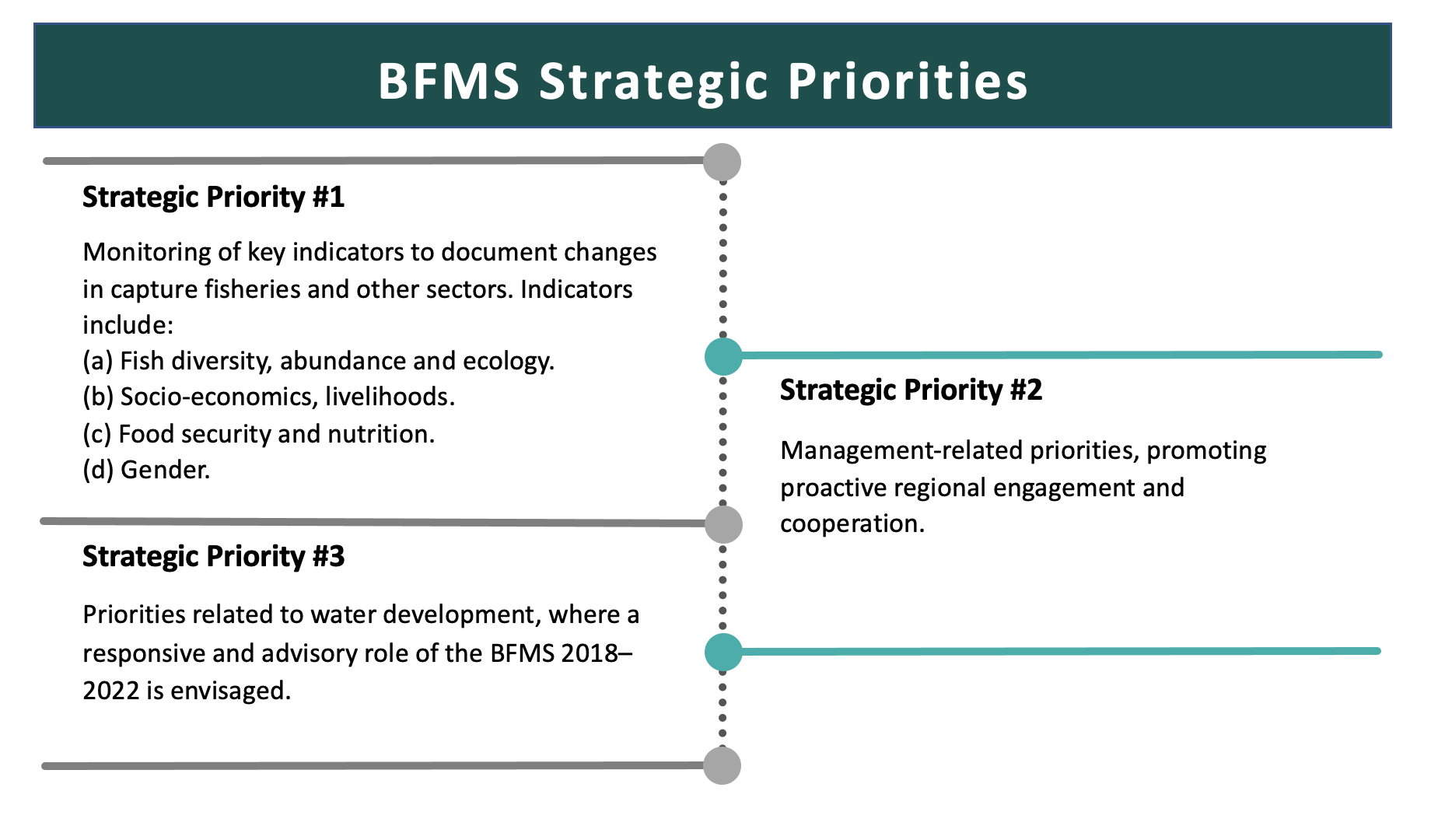
Figure 15. Strategic priorities of the Mekong Basin-wide Fisheries Management and Development Strategy
Joint Transboundary Projects Completed in 2019, this project aimed to promote bilateral cooperation as another tool (in addition to regional and multilateral) for more targeted cooperation in IWRM practices and address more localized transboundary water issues between two neighbouring MCs. Three Joint Transboundary Management/Action Plans were developed and endorsed by MCs for implementation. These include a transboundary fisheries management plan for the Mekong-Sekong River Basins between Cambodia and Lao PDR, and transboundary joint action plans for the IWRM for Sesan and Srepok River Basins, and for the Mekong Delta between Cambodia and Viet Nam. The plans include measures, priorities and actions required to implement cooperation mechanisms with identified lead responsibility. Other reports produced to document the findings, best practices, and lessons learned, and help institutionalize IWRM principles in transboundary bilateral cooperation include: • Transboundary Fisheries Management in the Mekong and Sekong River of Cambodia and Lao PDR (2017) • Transboundary Water Resources Management Issues in the Sesan and Srepok River Basins of Cambodia and Viet Nam (2017) • Transboundary Water Resources Management Issues in the Mekong Delta of Cambodia and Viet Nam (2017) • Joint paper on wetland management and joint report on knowledge exchange on community water management for Xe Bang Hieng and Nam Kam River Basins between Lao PDR and Thailand • Joint learning report to capture process in the establishment of a joint network between Tonle Sap and Songkhla Lake project between Cambodia and Thailand. In 2018, under the Cambodian and Thai NIPs, the Joint Project on Flood and Drought Management in the Cambodia-Thai Border Area was initiated. The area of interest is specifically the Tonle Sap 9C-9T sub-basin, 27% of which is located in Thailand, and the remaining 73% in Cambodia. During Phase 1 (2018–2019), an assessment of flood and drought risks in the sub-basin was conducted, and elements of a mitigation master plan developed to address the risk. The mitigation master plan identified five priority areas, 18 potential mitigation project concepts, and a number of options for Cambodia – Thailand governance mechanisms for the project. In 2018, under the Cambodia and Lao NIPs, the Joint Project on cross-border water resources development and management in the Khone Falls region between Cambodia and Lao PDR was initiated. The objective was to develop a long-term vision that reflects the aspirations and development objectives of the Khone Falls region shared by Cambodia and Lao PDR for Stung Treng and Champasak provinces, respectively, and joint actions that will generate mutual benefits in both provinces. From May 2018 to April 2019, through a participatory process, the two countries developed and agreed on a coordinated vision for 2040 and nine joint actions for Stung Treng and Champasak provinces for mainstreaming into the provincial investment and development plans. The joint actions are related to tourism, fisheries, trades, land use planning, information sharing, employment, agriculture, gender, and flood management.
Climate Change Adaptation Strategy The strategy sets out LMB countries’ strategic priorities and actions at the basin level to address climate change risks and strengthen basin-wide resilience (see Figure 16). Since 2018, the MRC has been implementing MASAP as per its action plan, which consists in incorporating MASAP climate change strategic priorities in the BDS and other sectoral strategies such as drought, environment and fisheries. It also consists in mainstreaming climate change adaptation planning at the national level.
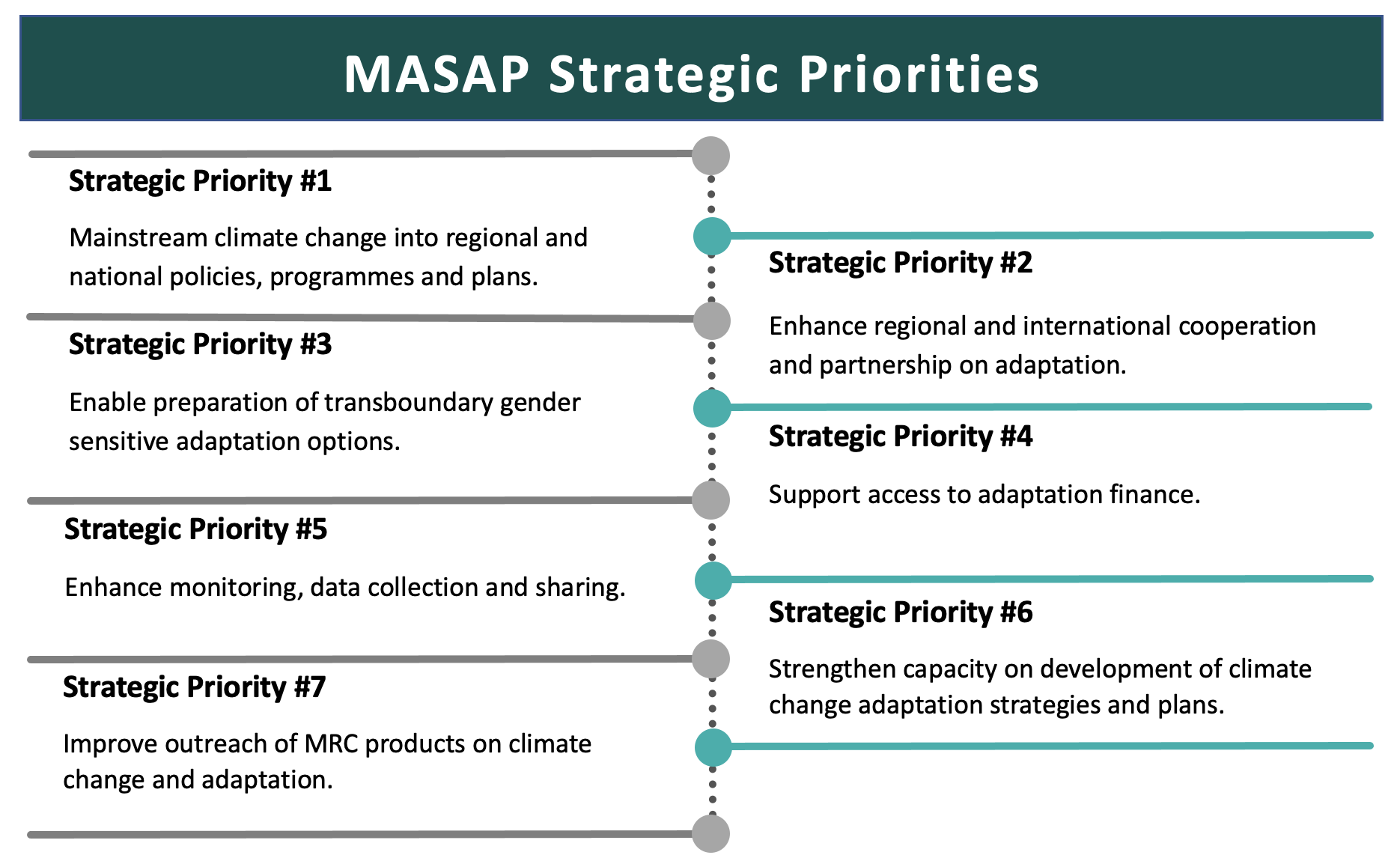
Figure 16. Strategic priorities of the Mekong Climate Change Adaptation Strategy and Action Plan
Environment Strategy As this is the first strategy of its kind that covers the entire LMB, the SBEM aims to protect and conserve an initial list of 12 environmental assets due to their importance regionally in supporting basin-wide processes or due to their transboundary nature. Its Project-Based Action Plan was finalized by the Expert Group on Environmental Management in December 2020. Other key accomplishments include the completion of two technical guidance documents for the Environment Strategy: (i) Technical Guidance for protection and restoration of key fish habitats with regional importance in the LMB; and (ii) Technical Guidance for transboundary fisheries management in the LMB (see Figure 17).
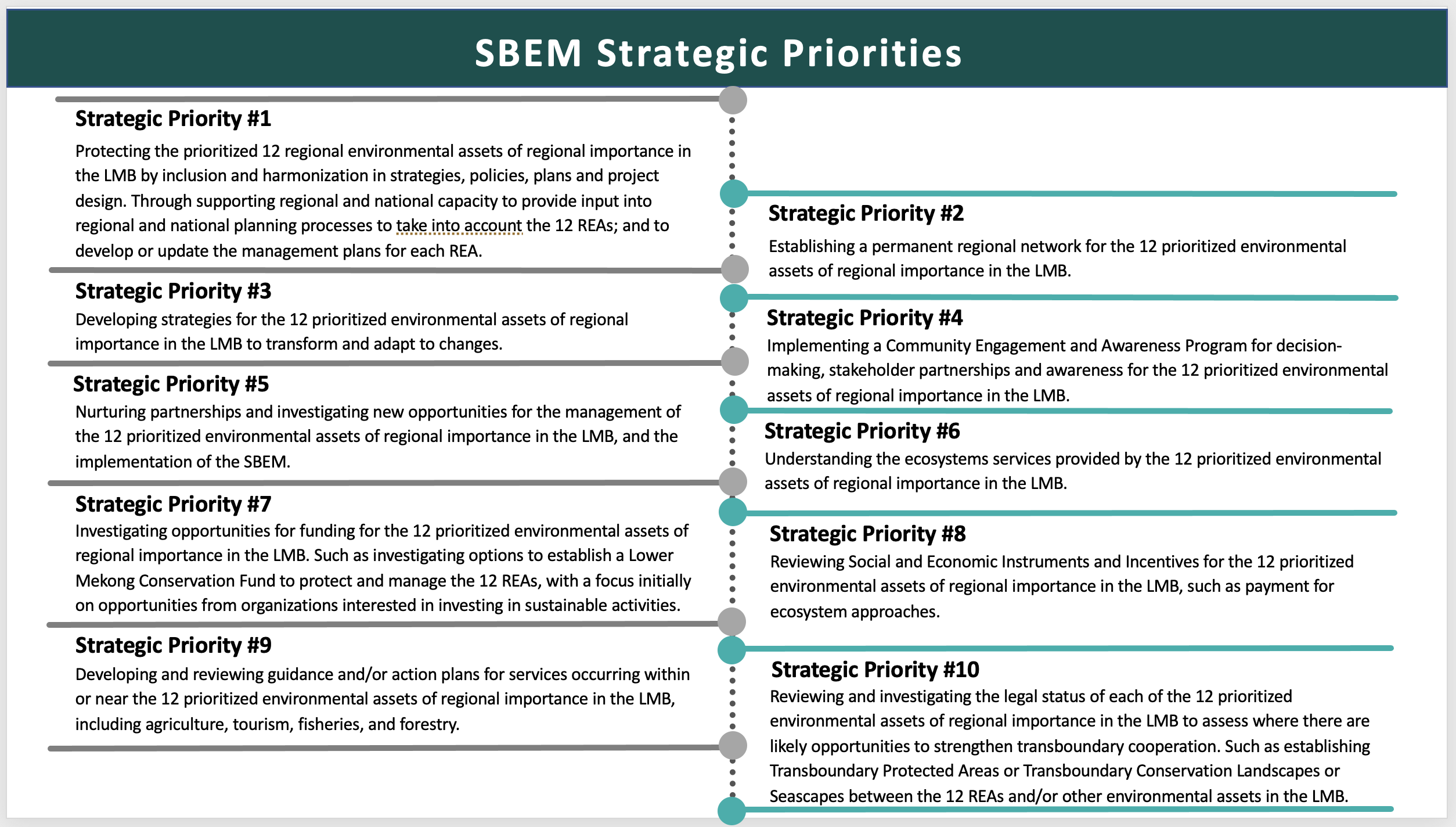
Figure 17. Strategic priorities of the Strategy for Basin-wide Environmental Management
Navigation Master Plan The Master Plan for Regional Waterborne Transport in the Mekong River Basin (Navigation Master Plan) includes a list of over 100 short- and long-term navigation projects was prepared in October 2017. Five priority projects require immediate implementation. It is the MRC's regional plan to develop waterborne transportation sector in the Basin to achieve the goal of increasing waterborne transport at least 125% of the actual waterborne transport volume in 2020 and to a least 250% of the actual waterborne transport volume in 2040. It also aims to make navigation safer and more sustainable for the people and for the environment.
Regional Drought Management Strategy The regional Drought Management Strategy (DMS) aims to bring improvements in five priority areas. As illustrated in Figure 18, these strategic priorities include: (i) water use, hydrometerology, groundwater, soil moisture, and salinity monitoring; (ii) drought monitoring, forecasting, and early warning; (iii) MRC capacity on drought assessment and planning; (iv) impact mitigation and regional collaboration; and (v) information and data sharing.
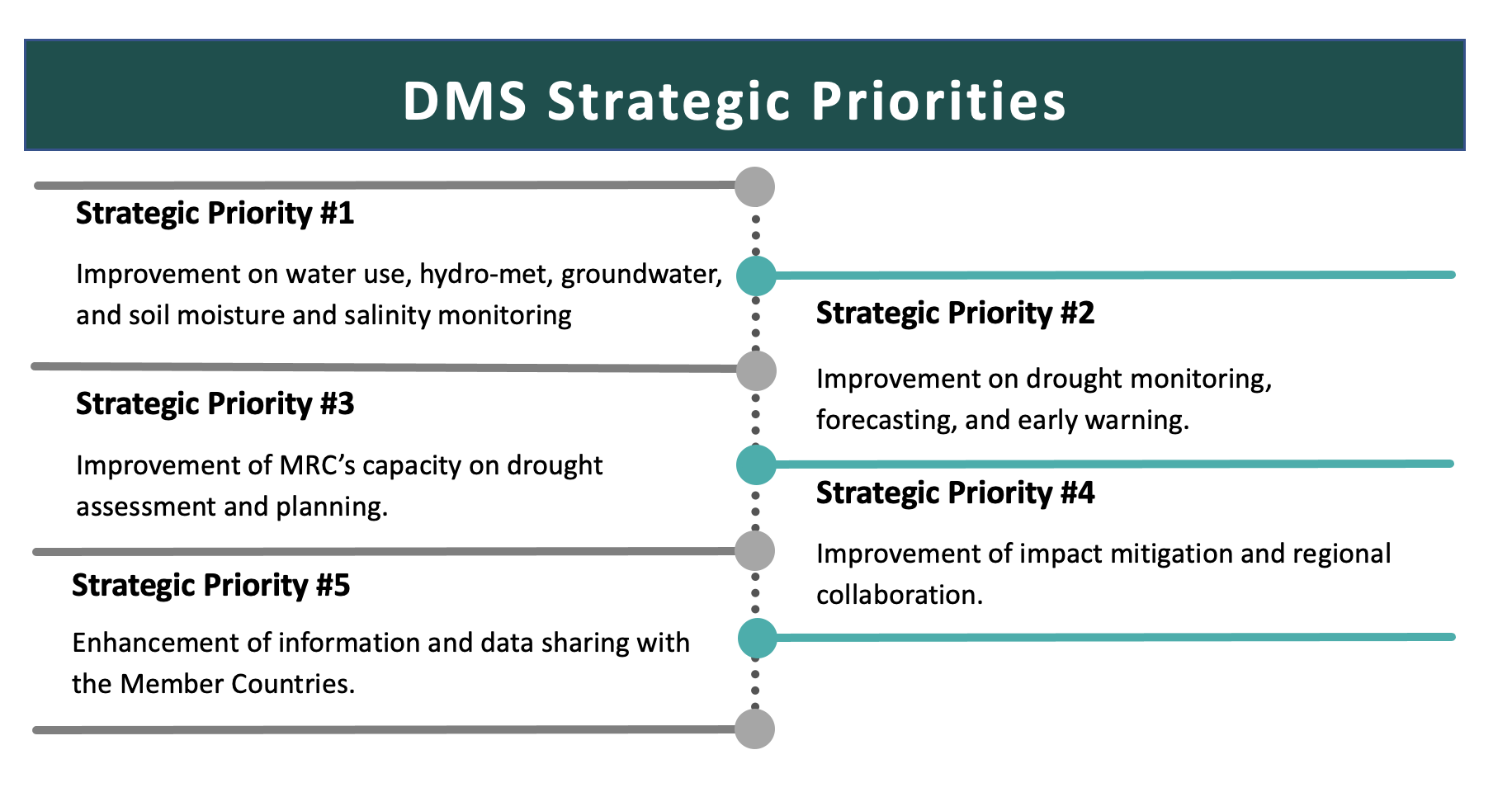
Figure 18. Strategic priorities of the Regional Drought Management Strategy
The Gender Action Plan In 2017, the MRC completed its first GAP to implement its gender policy in the context of the new SP. The MRC GAP consists of practical tasks to address gender equality at both institutional and activity levels, including technical capacity, leadership commitment, accountability, and organizational culture. GAP activities aim to ensure that technical skills for gender mainstreaming are strengthened, a positive organizational culture is promoted, and a mechanism for individual, programmatic and organizational accountability is in place.
The Basin Development Strategy (BDS) 2021–2030 and the MRC SP 2021–2025 The new BDS/MRC SP recognize the MRC’s shift in focus from primarily on cooperation for knowledge acquisition and sharing, towards more proactive planning, integrated river and environment monitoring and forecasting, coordinated operation of water infrastructures, and a high level of cooperation among the MCs and between them, and the Upper Mekong countries and relevant regional cooperation frameworks in order to ensure a more integrated Mekong-Lancang management arrangement for the entire Mekong River Basin (see Figure 19).
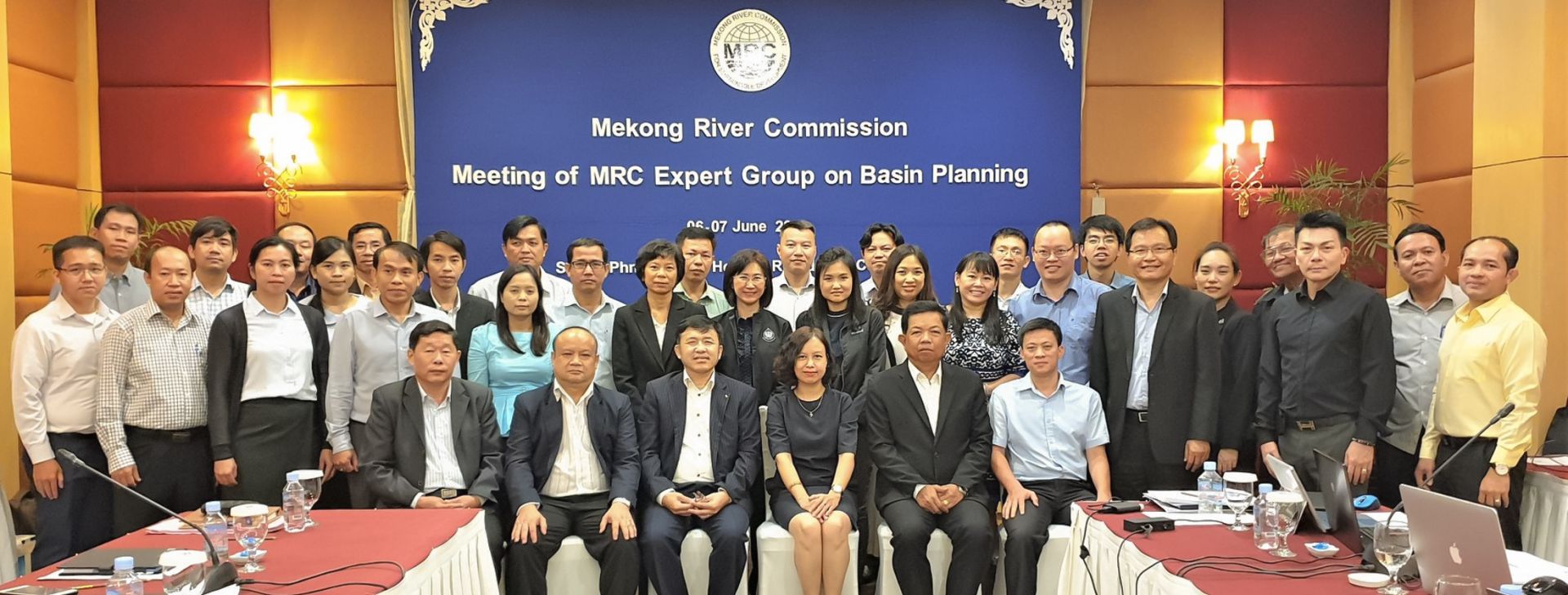
Regional experts gather at the MRC Expert Group on Basin Planning Meeting, in Phnom Penh, Cambodia (6 and 7 June 2019)
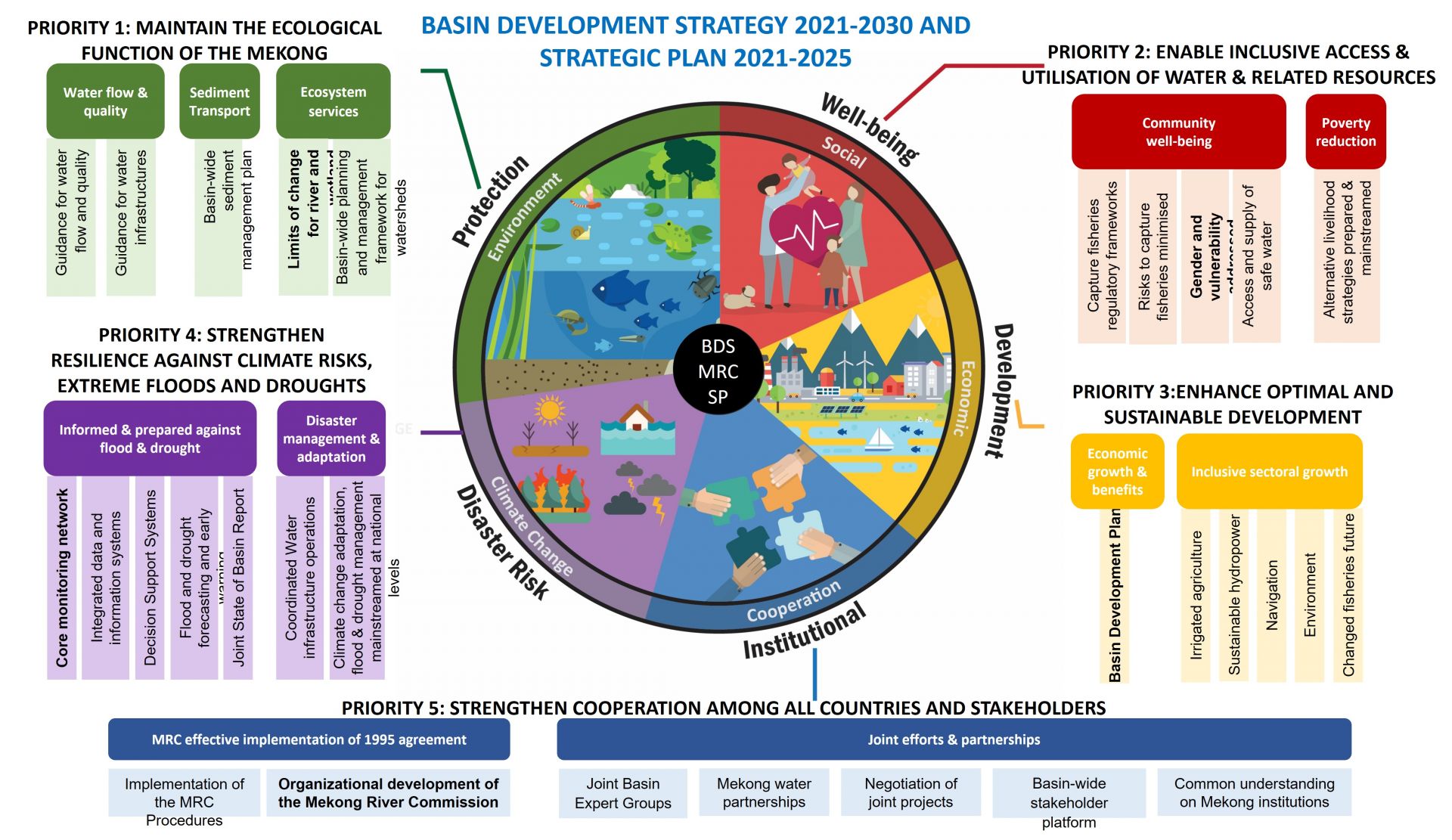
Figure 19. Priorities of the new BDS 2021–2030 and the MRC SP 2021–2025.
Study on irrigation impacts Irrigation is by far the biggest water consumptive sector in the Basin. Sub-optimal planning and implementation of irrigation projects combined with the uncertainties imposed by climate change may therefore result in negative transboundary impacts on water availability and the environment. In addition to assessing the impacts of irrigation projects, the study also includes the potential for groundwater development and management for production. The agricultural land use monitoring component of the study on transboundary impacts of irrigation, which was based on implementing pilot studies in MCs, was completed in 2019 with the final report published on the MRC website. For the groundwater component, the Inception Report on Sustainable Groundwater Use and Management was completed. The study on water requirement and availability for drought management The study aimed at estimating water deficits for crop areas of the LMB under different scenarios: baseline from 1984 to 2007, future scenario from 2007 to 2020 without climate change considered, and future scenario from 2020–2040 with climate change considered. The study indicated that the current irrigated agriculture faces extreme water deficits, especially in Cambodia and Thailand, and that the water deficits may increase in the future during the dry season. This study was used to inform the preparation of the DMS.
Evidence of change
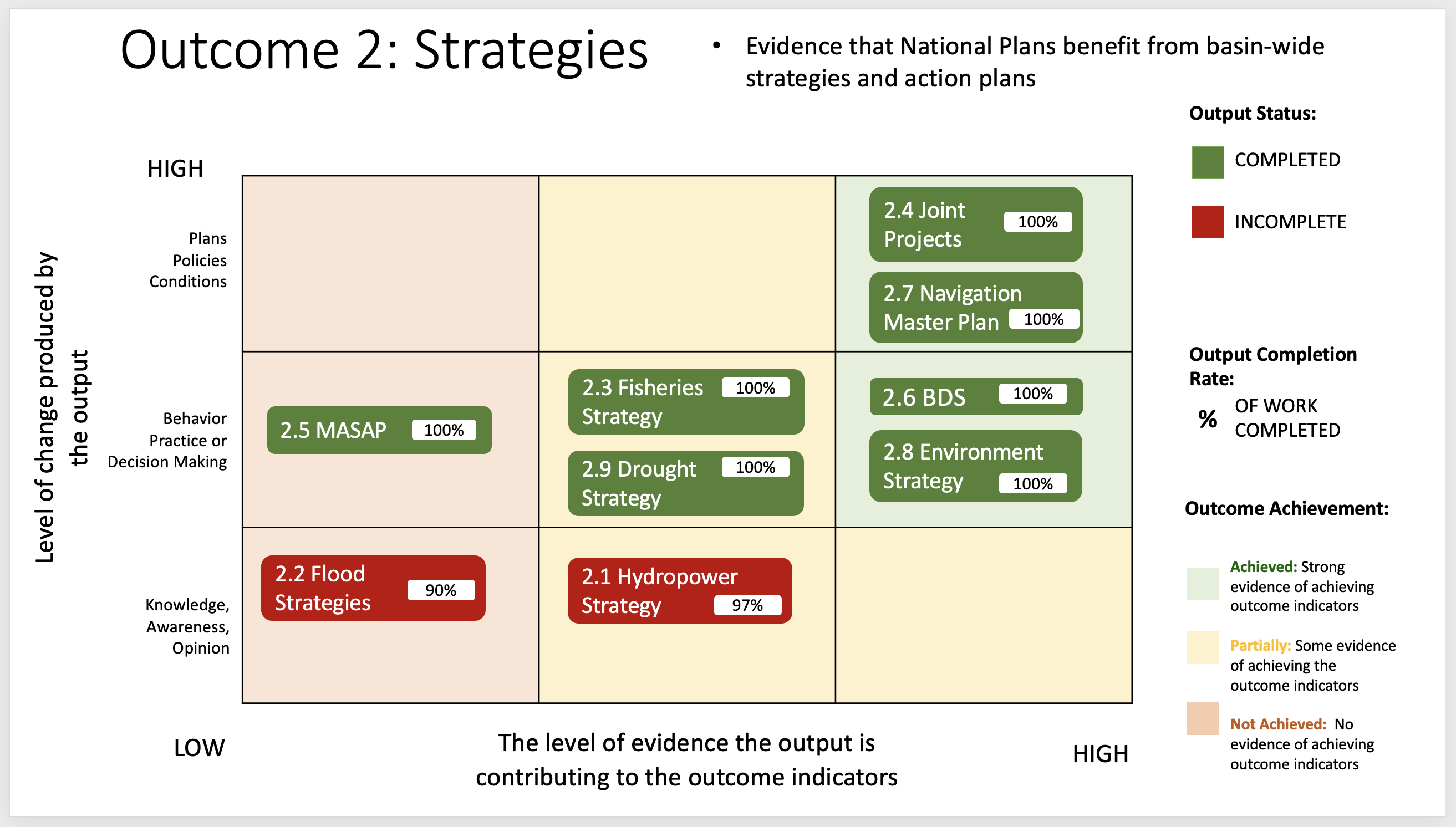
Figure 20. Outcome Evaluation Matrix
Note: The Matrix assesses outcome achievement based on output completion and the type of change that occurred – Outcome 2
Increase in knowledge and understanding The development of the BDS 2021–2030, SP 2021–2026, and basin-wide sectoral strategies has significantly increased the institutional capacity of the MRC and the MCs in holistic and multisectoral strategy development and regional basin planning to address not only long-term needs, but also pressing and urgent issues. These strategic, collaborative efforts have led to a common acceptance and understanding, and an increase in confidence that the regional strategies will complement the national strategies. Both the SBEM and the BDS served as a catalyst for the acceptance by the MCs that there is a need for a Mekong Fund, which started as a general concept and is now under more serious consideration as a potential mechanism to bring in resources to address not only environment issues, but also livelihoods and adaptation to climate change. The development of the regional strategies has also heightened the level of cooperation among the MCs. During the development of the DMS, for example, the MCs, recognizing the urgent need to coordinate their drought mitigation actions, worked together to produce a highly informative and valuable inventory of ongoing and planned mitigation actions by responsible agency for each MC. The Joint Projects demonstrated that more localized transboundary issues between two MCs can be more effectively addressed through bilateral cooperation. For instance, the bilateral cooperation between Cambodia and Viet Nam has led to joint transboundary action plans in the Sesan and Srepok River Basins and the Mekong Delta to address emerging water resources development issues. These plans set out the goals, objectives, and activities with identified leads, a tentative completion date, and an estimated budget for implementation. It was evident that the implementation of the GAP led to MRC activities under all outcomes that incorporate gender equity and equality considerations, both in technical activities (i.e. the preparation of the SOBR, the SHDS, the SIMVA, the BFMS, and the Environmental Strategy) and in organizational strengthening (i.e. Human Resources hiring practices that ensure that the MRC Secretariat is relatively balanced in terms of male and female staff, job descriptions, trainings, meeting participation and relevant manuals). As a result of the MRC's efforts in collecting and monitoring by gender the participation in MRC events, the level of female participation has subsequently increased. The number of women participating in the MRC events as facilitators, moderators, and presenters has also increased.
Use in regional and national planning and decision-making The completion of the regional strategies and their approval by the MRC Council paved the way for the MRC to move towards implementing a basin-wide approach across all water and related development and environment sectors of the Mekong. "Development Partners congratulate the MRC on the adoption of the Basin Development Strategy for 2021–2030, the Strategic Plan for 2021–2025, and the Multi-Year Work Plan for 2021–2022. They are all comprehensive documents of high quality.” – Joint Statement of Development Partners, November 2020 “The Basin Development Strategy and the MRC Strategic Plan are comprehensive action plans to address issues facing the Mekong. If implemented, this will be a turning point for the Basin.” – Representative of Save the Mekong Coalition, April 2021 In addition to the agreement to conduct proactive planning, which seeks to assess and recommend new basin-wide and joint investment projects to serve multiple purposes, the new BDS 2021–2030 and the MRC SP 2021–2025 also expanded their scopes to include regional coordination of operation management of dams and other water infrastructure that may have transboundary effects, including for river flow management, sediment management, ecosystem services, management of emergencies, and coordination of the design and management of hydropower cascades. The experience gained and lessons learned during the strategic planning cycle 2016–2020 have led the MRC to be more systematic and more precise in linking outputs to outcomes with the use of indicators. This increasing sophistication and focus on results, which started in the BDS 2016–2020, became more evident in the strategic planning cycle for 2021–2025 for which the MRC designed the results chain of the BDS and the SP to be fully integrated and the impact pathway from output to outcome fully described. This alignment and integration between BDS and MRC SP allow the MRC to plan and implement activities that will clearly result in contributing to the BDS outcomes and strategic priorities. In addition, the MCs have used the Navigation Master Plan to help them with their respective investment planning to improve river navigation. Cambodia, Lao PDR, and Viet Nam have implemented a number of the projects identified in the Master Plan. The Environment Strategy has influenced Lao PDR’s decision to update the management plans of the two prioritized environmental assets, the Beung Kiat Ngong Ramsar Wetland, and the Xe Champhone Ramsar Wetland. Cambodia, under its national strategy and action plan, is already managing two of the prioritized EAs, Tonle Sap Multiple Use Area and Virachey National Park. In addition, in Cambodia and Viet Nam, the Environment Strategy has initiated the co-management and co-financial mechanisms of Yok Don National Park, a prioritized environmental asset that occupies both countries.